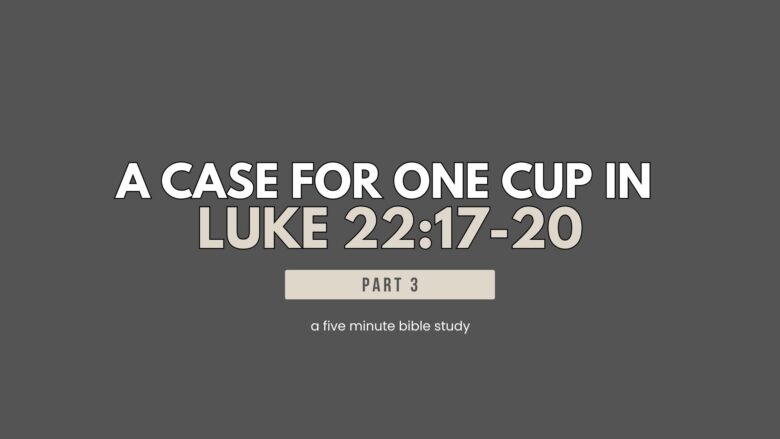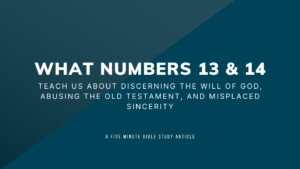Putting everything together from Part 1 & Part 2 of this mini-series, I would like to briefly conclude this study of chronology in Luke’s gospel by giving three conclusions for why I believe there is really only a single cup in the Luke 22:17-20 account of the last supper. This is not an exhaustive defense for one cup in Luke 22:17-20, but here are what I believe to be the most compelling proofs.
1) There is no evidence that 1st century Jews or Jesus used four cups in their observance of the Passover.
Most commentaries of Luke 22:17-20 will note in v. 17 that the cup Jesus took in this verse was the fourth cup used in the Jewish tradition of the Passover meal. However, there is zero evidence that such a practice was in place during the time of Jesus. There is certainly no evidence within the scriptures themselves, and the evidence that usually is cited comes from rabbinic traditions that post-date the destruction of Jerusalem. Fingers typically point to Rabban Gamaliel.[1] It is commonly supposed that this is the only explanation for why Jesus seemingly took two separate cups in Luke’s account. But as has been shown already and will be shown in the following points, this is not the only reasonable explanation for the apparent two cups in these verses.
2) If Luke 22 is reporting chronologically then why do none of the other two gospel accounts or 1 Cor. 11 report the supper as being fulfilled in the manner of cup—loaf—cup?
A chronological interpretation of Luke 22:17-20 does not harmonize with the other gospel accounts. A non-chronological interpretation harmonizes perfectly with both Matthew and Mark.
3) Mark 14 objectively reports the example of what Jesus and the disciples did at the observation of the Lord’s Supper, yet he makes no mention of a second cup.
Matthew and Luke report what Jesus said at the Last Supper, but Mark reports what He and the disciples did. In Mark’s account of what they did, the Lord’s Supper procedure contradicts that presented by Luke, if indeed Luke 22:17-20 is a strict chronological sequencing of Jesus implementing the Supper. If Luke’s account of the supper is, in fact, not sequenced strictly chronologically, then there is no contradiction. Mark’s account helps bring clarity to the actual number of cups that Jesus used in the Last Supper. One.
Conclusion
My final conclusion about Luke 22:17-20 is that Jesus took up a single cup. In v. 17-18, Jesus emphasizes the need to drink from the cup as well as its significance to the kingdom of God. In v. 20, Jesus emphasizes the significance of the same cup as it pertains to the new covenant. The cup is the token of the new covenant and inside the cup is the fruit of the vine that is representative of the blood which made that covenant effective. Luke inserts the account of Jesus taking up the bread between these two statements (v. 19). It’s reasonable to assume that Luke creates this sequence (A-B-A or cup-bread-cup) to distinguish and emphasize these two different significances of the cup, or perhaps there is some other literary reason. Whatever the real reason for this repetition by Luke, it would seem from the evidence in this study that there is a burden of proof on those who would insist that Luke records the Last Supper by adhering to a strict chronological sequencing. Such a reading would reshape how we read the sequence of events in Matthew and Mark’s accounts. But is this necessary, and more importantly, is this likely? My conclusion is no.
This article has given a significant amount of evidence that historical narratives within the Bible as a whole do not necessarily give priority to chronology, especially Genesis, Judges, and Luke. It is falsely and readily assumed that the Bible is written with a strict adherence and priority given to chronological retelling of events, but clearly this is not the case. Perhaps this is the result of how westerners are conditioned to read history in modern times where chronology is assumed. Consider these things in the light of God’s perfectly inspired word.
[1]Klawans, Jonathan. “Was Jesus’ Last Supper a Seder?” Biblical Archaeology Society, https://www.biblicalarchaeology.org/daily/people-cultures-in-the-bible/jesus-historical-jesus/was-jesus-last-supper-a-seder/#note14r. Accessed 31 March 2023. Read the section of the article entitled “The Development of the Modern Passover Seder.” Klawans gives a helpful and concise summary of the late Passover observance traditions that are commonly read anachronistically into Jesus’ observance in Luke’s gospel.



